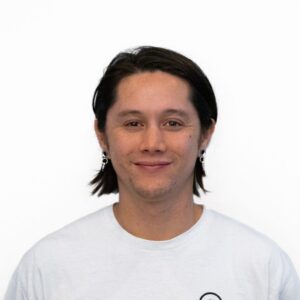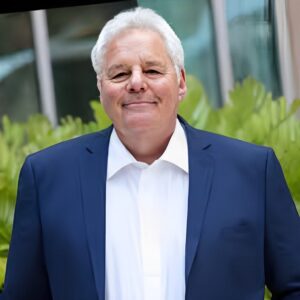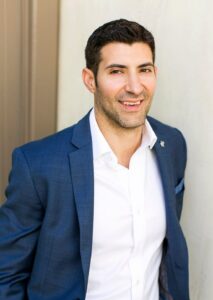An Interview With Fotis Georgiadis
Don’t compare yourself to others. When looking at other people’s relationships, it is often said that “you don’t know what happens behind closed doors.” This acknowledges that outward appearances can be misleading. The same is true in academics and professional careers! Other people may look like they are flying through school or climbing the ladder at work with ease, but you often can’t see the effort people put in privately, the late nights, the sacrifices, the tutor, the coaching sessions. I spent a lot of time during my career feeling “less than.” That was wasted emotional energy. It is best to focus on yourself. Celebrate your strengths, work on your weaknesses, and keep going.
As a part of my series about “Big Ideas That Might Change The World In The Next Few Years” I had the pleasure of interviewing Dr. Grace Andrews.
Dr. Grace Andrews, who has dedicated her career to combating climate change. She is featured in an original documentary and educational series on Wondrium called “Solving for Zero” that highlights technological advances that will help our planet reach net zero carbon emissions by 2050.
As Vice President of Scientific Research at Project Vesta, Grace is working on a global solution to remove carbon dioxide from the Earth’s atmosphere by distributing a naturally occurring mineral, olivine, in coastal areas. Her research focuses on coastal carbon capture as a negative emission technology to mitigate climate change. Prior to joining this innovative company, she worked at the Leverhulme Centre for Climate Change Mitigation implementing terrestrial enhanced weathering trials at locations around the globe. She has a Ph.D. in Earth and Planetary Sciences from Northwestern University where she received the Horace A. Scott Graduate Award for Outstanding Research.
Thank you so much for doing this with us! Before we dig in, our readers would like to get to know you a bit. Can you please tell us a story about what brought you to this specific career path?
My senior year of high school I was like a lot of other kids, incredibly excited to be leaving home and going to college but simultaneously entirely overwhelmed because I had no idea what I wanted to do with my life. What I did know was that I wanted a life of purpose and impact and adventure, but I had no clue how to make that happen. That changed when Al Gore’s documentary, “An Inconvenient Truth”, premiered the summer before I started university. Watching that film crystallized for me the global challenge that I knew I had the interest and talent to tackle. A few months later, I started university already declared as an Earth Science major, and I’ve never looked back.
Knowing that a documentary on climate change truly helped shape the course of my life makes my role in Wondrium’s “Solving for Zero” all the more meaningful to me. I hope that I am able to ‘pay it forward’ and through this film, and my story, propel at least one more person towards an impactful career in climate change mitigation.
Can you please share with us the most interesting story that happened to you since you began your career?
Prior to joining Project Vesta, I spent a number of years launching field pilots of a Negative Emission Technology (NET) called terrestrial enhanced weathering. One of the pilots was conducted in a remote corner of an oil palm plantation in Malaysian Borneo. I spent months, cumulatively, living on the plantation building our field station and developing the pilot. The perspective-changing experiences I had during this time are probably enough to fill a book with, but one experience always jumps out when I reflect on my time there.
On one occasion a senior-level executive came to the plantation to meet with me and about 20 of my colleagues. Our meeting was held over dinner, and we sat around a large dining table with the executive squarely at the head of the table. When he talked, everyone listened. When he joked, everyone laughed. I have never seen anyone “hold court” quite the way he did. And when the eyes of the men sitting across from me diverted as I tried to engage in conversation, it occurred to me that I was the only woman at the table.
After dinner, I decided to go for a walk. But as I set off to go, a group of women that had been working in the guest house kitchen, some who had been serving us all night, emerged and started milling around me. When I started walking, they followed. My Malaysian colleague joined us and translated what was happening — this group of women, maybe eight in number, wanted to walk with the woman who had sat at the table.
They had never seen a woman sit at the table before. And so we walked. One or two of the women walked silently beside me, as we didn’t share a language, and the rest trailed right behind. And each step of the walk pressed into me the very literal importance of my having a seat at the table.
Which principles or philosophies have guided your life? Your career?
As a scientist, and as an executive, there is often pressure to “have all the answers,” to sound smart, to seem competent. I fundamentally believe that the best scientists, and the best leaders, know what they don’t know and aren’t afraid to ask someone who does know. Appearances will only get you the first mile of the marathon. Ultimately, respect and success come to those who have sound judgment and make good decisions. That only happens when you’re informed.
Ok thank you for that. Let’s now move to the main focus of our interview. Can you tell us about your “Big Idea That Might Change The World”?
I am the VP of Science at a company called Project Vesta. We’re developing a Negative Emission Technology called Coastal Carbon Capture (CCC) to remove carbon dioxide (CO2) from the atmosphere and help mitigate climate change. The mechanism behind CCC is fundamentally based on accelerating the Earth’s natural process for regulating atmospheric CO2 levels, a process called chemical weathering.
CCC works by simply placing sand, made from the natural mineral olivine, in coastal waters. When olivine sand interacts with seawater and CO2, it drives a reaction that takes CO2 out of the air and generates a form of dissolved carbon in seawater that, conveniently, is the antidote to ocean acidification. Because the ocean is so big, there is an abundance of space to implement this strategy and ultimately have a meaningful impact on climate change. We estimate that if CCC was deployed on just 0.25% of coastal shelves, we could remove a billion tonnes of CO2 from the atmosphere. Right now, Project Vesta is building out a number of very small pilot trials of CCC all over the world, including in the Caribbean, to test the safety and efficiency of CCC in a natural setting.
How do you think this will change the world?
I think CCC could be a significant piece of the climate change mitigation puzzle. It is not a silver bullet — no climate mitigation strategy is — but it is scalable, affordable, and can be implemented by any community, state, or country with coastline.
Keeping “Black Mirror” and the “Law of Unintended Consequences” in mind, can you see any potential drawbacks about this idea that people should think more deeply about?
The mechanism behind how CCC removes CO2 from the atmosphere is very simple, just add olivine sand to the ocean. In practice, safely and efficiently implementing CCC, as well as robustly monitoring it, are challenges that I spend most of my time thinking about. I think a risk with CCC is that rogue actors may not appreciate its complexities and try to irresponsibly implement it. Having diligent, universal deployment guidelines and monitoring requirements is essential to ensuring that in all cases CCC, and similar climate mitigation strategies, are executed to the highest possible standard.
Was there a “tipping point” that led you to this idea? Can you tell us that story?
There was not really a “tipping point” that led me to believe CCC could be successful, but rather a slow and steady accumulation of knowledge and experiences. I spent my Ph.D. studying chemical weathering, Earth’s natural process of regulating CO2 levels, and the years after that working on terrestrial enhanced weathering, the land-based counterpart to CCC. When I brought together both my scientific understanding of carbon removal processes, as well as my understanding of the technological challenges associated with scaling NET’s and bringing them to market, CCC clearly stood out as having the ability to succeed.
What do you need to lead this idea to widespread adoption?
CCC cannot achieve widespread adoption without social license. Right now, Negative Emission Technologies are still foreign to most people. For a lot of good reasons, the things we don’t understand often seem scary. We need people, communities, states and nations to commit to solving the climate crisis, and to do so, we need everyone to invest in learning, ask questions, and ultimately, demand change.
What are your “5 Things I Wish Someone Told Me Before I Started” and why.
1. Find an advocate. The most efficient path to a successful career in STEM is through those who have come before you. Starting my freshman year of university, a professor in my department gave me the opportunity to do research in his world-class laboratory, took me to conferences, and encouraged me to take graduate-level classes. The rest of my career has precipitated from these opportunities. In retrospect, I feel that I stumbled into having a tremendous career advocate early on. I wish I was more conscious of the importance of this relationship at the time. To others I say: do not be afraid to seek out potential advocates. You have so much to gain and quite literally nothing to lose.
2. Consider your career goals carefully before pursuing a Ph.D. A Ph.D. is absolutely essential for a few, certain jobs. Beyond that handful of positions however, it over-qualifies you for the rest. Don’t spend five years pursuing a Ph.D. unless you are sure it’s required to get you where you want to be. In my own pursuit of a Ph.D., I was not as mindful as I should have been, as I encourage others to be. It worked out in my case, and I’m grateful for that, but it is easy for me to see how things could have ended differently.
3. Don’t compare yourself to others. When looking at other people’s relationships, it is often said that “you don’t know what happens behind closed doors.” This acknowledges that outward appearances can be misleading. The same is true in academics and professional careers! Other people may look like they are flying through school or climbing the ladder at work with ease, but you often can’t see the effort people put in privately, the late nights, the sacrifices, the tutor, the coaching sessions. I spent a lot of time during my career feeling “less than.” That was wasted emotional energy. It is best to focus on yourself. Celebrate your strengths, work on your weaknesses, and keep going.
4. It’s okay to wander a bit. Some people have career paths that run as straight as an arrow. It’s okay if yours doesn’t. As long as you’re gaining meaningful life experiences, you’re growing, developing, and learning in ways that will have an important mark on your future work. See Point 5.
5. Technical skills will get you started in your career but soft skills are what separate out the leaders. The best thing I have ever done for my career was spend a few months in couples therapy with my husband revamping my communication skills. Effective, interpersonal communication is critical for successful team management. If this is an area where you feel you are lacking, take it upon yourself to learn the soft skills and practice implementing them at home or at work, no matter what stage of your career you are in. You are setting yourself up for success.
Can you share with our readers what you think are the most important “success habits” or “success mindsets”?
Prioritize work-life balance. I put “family time” on my work calendar and make no exceptions. My family is my root source of joy and motivation, and my best work is done when that side of my life is flourishing as well. Some of this family time and the importance I place on it is even highlighted in the Wondrium documentary “Solving for Zero.”
I also believe you should make time to care for yourself. When you feel good about yourself, you have natural confidence. This will permeate into your work.
During conflict or disagreements with others at work, treat the professional relationship largely as you would a personal relationship because everyone just wants to feel heard, understood, and valued, be it in the home or workplace. When conflict arises, give the benefit of the doubt, acknowledge your own mistakes, and most importantly, speak not from a place of anger or annoyance but from a place of empathy. This will build a committed and loyal team.
Some very well-known VCs read this column. If you had 60 seconds to make a pitch to a VC, what would you say? He or she might just see this if we tag them 🙂
Coastal Carbon Capture is a solution that addresses not just the root cause of the climate crisis (rising CO2 levels) but also the symptoms (ocean acidification, coastal erosion). By adding sand made from the natural mineral olivine to coastlines, CO2 is removed from the atmosphere and stored permanently in the ocean as alkalinity, the antidote to ocean acidification. The added sand can also contribute to the protection of coastal homes, livelihoods, and habitats currently threatened by sea level rise. Due to the Earth’s vast coastal area, CCC has massive potential to scale and combat climate change. If deployed on just 0.25% of Earth’s continental shelf, we could remove one billion tonnes of CO2 from the atmosphere.
How can our readers follow you on social media?
You can find me on twitter, @mgrace_andrews. And if readers want to learn more about the work I’m doing on Coastal Carbon Capture, they can watch #SolvingforZero on wondrium.com and follow @wondrium on any social platform.
Thank you so much for joining us. This was very inspirational.
Project Vesta: Dr Grace Andrew’s Big Idea that Might Change the World was originally published in Authority Magazine on Medium, where people are continuing the conversation by highlighting and responding to this story.



